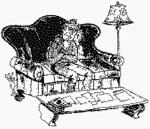ALTERNATIVES:
8.1. Create a "Storyboard" on a wall in a designated area of your home office to act as a Design-Build collage. Dedicate one half for exterior ideas and the other half for interior ideas. Hang pictures, colors, samples, sketches, et cetera on the wall so you begin to visualize the entire ensemble of patterns and textures for your homestyle. Read Susanka’s Creating the Not So Big House and Tolpin’s The New Family Home.
REFINEMENT:
8.2. Expand the "Storyboard" with exterior and interior colors, patterns, and textures. Start grouping combinations that seem to go together so you can compare and contrast one grouping to the other. Ask your friends and family members for their opinions. Enjoy being an artist! Take a peek at Clodagh’s Total Design.
DOCUMENTATION:
8.3. Turn a critical eye to the combinations depicted on the "Storyboard.” Eliminate colors, patterns, and textures that obviously won't be considered for your project. Don't throw anything away but select several combinations of exterior and interior treatments that satisfy you the most. Be sure samples are marked with manufacturer product information, including distributor and contact person. Get a few tips from Benzel’s The Room in Context.
NEGOTIATION:
8.4. Select a combination of colors, patterns, and textures for exterior and interior treatment. Your "Storyboard" should appear purposeful and artful! Each manufacturer will attach a specific name and/or number to a color, pattern, or texture for their product. It's very important that you indicate this name/number when your purchase products and materials from a supplier or through a trade contractor.
MANAGEMENT:
8.5. Confirm product/material choices from the "Storyboard." Double-check specific names and numbers to be certain the correct color, pattern, or texture has been ordered. Inspect product and materials before installation to verify product correctness. To the greatest extent possible, make quality control the responsibility of the manufacturer and distributor. Glance through Bliss’ Troubleshooting Guide to Residential Construction.
DILIGENCE:
8.6. Take a picture of your Design-Build collage in its final form. Clear the wall of the "Storyboard." Color, pattern, or texture samples should be labeled with manufacturer name and identification number for future reference. Double-check product installation to verify correct models/colors have been utilized. Refer to Hoffman’s How to Inspect a House.
FOLLOW-UP:
8.7. Store "Design/Build Collage" in the "Cardboard Box Files" in its respective file folder. Utilize the “Storyboard” technique on other projects.
FURTHER READING:
The format we use to arrange the complexity of information is a residential Design/Build Matrix. We use this format to organize project details so decisions can be made sensibly and sequentially for both architecture and construction.
 How do you differentiate between design and build events?
How do you differentiate between design and build events?
Let our "Design/Build Matrix" be a map to guide you.
We identify over 35 important issues for creating a "Design/Build" Action Plan!
BIBLIOGRAPHY:
Benzel, Katherine. The Room in Context.
New York: McGraw-Hill, 1997.
Bliss, Steven. Troubleshooting Guide to Residential Construction.
Richmond: Builderburg, 1997.
Clodagh. Total Design.
New York: Clarkson Potter, 2001.
Hoffman, George. How to Inspect a House.
New York: Addison-Wesley, 1993.
Susanka, Sarah. Creating the Not So Big House.
Newtown: Tauton, 1998.
Tolpin, Jim. The New Family Home.
Newtown: Tauton, 2000.